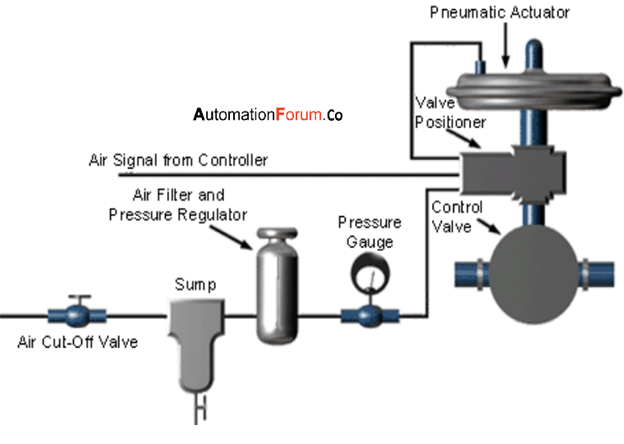How a Valve is controlled using a 4-20mA loop

Valve positioners are used to control the valve actuator position of the control valve. The positioner receives the signal from the controller and correct position by increasing or decreasing the air load pressure on the actuator.

Signal conversion
A 3 to 15 PSIG pneumatic signal would be sent from the loop device in the control chamber to the field valve prior to 4 to 20 mA digital command.
This signal sents to the positioned mounted on the valve. The positioner would compare the valve stem or shaft position with the loop controller’s 3 to 15 PSIG signal and output the correct pressure to the valve actuator to position the valve at the exact location defined by the loop controller’s 3 to 15 PSIG signal.
Control Valve Connection

4 to 20 mA signal is sent to the current-to-pressure (I/P) converter from the loop controller, which then displays a 3 to 15 PSIG signal to the positioner mounted on the valve, which operates as described above.
Some positioner designs have built-in I/Ps (also known as electro-pneumatic positioners). Some production facilities favour mounting the I/Ps remotely from the valve owing to vibration, temperature, crop norms, or some other issue.
4-20 mA Current Loop

Parts of 4-20 mA Current loop
Sensor
- A sensor of some kind that measures a process variable is necessary first. A sensor often detects pressure, flow, level, temperature, and humidity.
- Depending on exactly what it is used to monitor, the technology used in the sensor will vary greatly, but this is unimportant for our purpose.
Transmitter
- There must be a method for converting the sensor’s measurement into a current signal of between four and twenty milliamps, regardless of what it is measuring. A transmitter will be useful in this situation.
- A transmitter would need to interpret 0 feet as the tank being empty and then transmit a four milliamp signal if, for example, a sensor was monitoring the height of a fifty foot tank.
Power Source
- Just like in the water system example, there must be a source of water pressure, there must be a source of electricity for a signal to be produced. Keep in mind that the power supply must produce a DC current, which has a single direction of flow.
- Depending on the specific setup, a variety of standard voltages (9, 12, 24, etc.) can be used with 4-20 mA current loops. Be sure to take into account the fact that the power supply voltage must be at least 10% higher than the total voltage drop of the associated components (the transmitter, receiver, and even wire) when choosing what voltage to utilise for your specific arrangement.
- Equipment failure might result from the usage of insufficient power sources.
Loop
- A loop, or the actual wire connecting the sensor to the object receiving the 4-20 mA signal and then back to the transmitter, is necessary in addition to a sufficient VDC supply.
- According to the sensor’s measurement, the transmitter controls the current signal on the loop.
- Due to the fact that wire is an essential part of many modern electrical systems, this element is frequently ignored in a current loop arrangement, but it should be taken into account as we explore the foundations.
- While a segment of wire’s voltage drop can be caused by resistance in the wire itself, this is typically not a cause for concern because the voltage drop is so small.
- Nevertheless, depending on the thickness (gauge) of the wire, it might build up over lengthy lengths (more than 1,000 ft).
Receiver
- Finally, a device that can detect and decipher the current signal will be located somewhere in the loop.
- Units that are simple for operators to comprehend, like feet of liquid in a tank or degrees Celsius, must be converted from this current signal.
- Additionally, the information received must either be displayed (for monitoring purposes) or automatically used by this device. Incorporating digital displays, controls, actuators, and valves into the loop is common.
A 4-20 mA current loop can be completed using just these parts. The sensor takes a reading of a process variable, the transmitter converts that reading into a current signal, the signal goes through a wire loop to the receiver, and the receiver uses the signal to show something or do something.
Advantages & Disadvantages of 4-20 mA Current Loop
Determining whether the benefits outweigh the drawbacks is a difficulty for those who operate in industries where process control is necessary. Making the best choice can help you save time and money.
Advantages of 4-20mA Current Loop
- In many industries, the 4-20 mA current loop is the standard factor.
- The process of connecting and configuring is the simplest.
- It utilises much less wiring and connections than other signals, which significantly lowers the cost of initial setup.
- Better for long-distance travel because, unlike voltage, current does not diminish over lengthy connections.
- It is less susceptible to electrical background noise.
- Since 4 mA is equivalent to 0% output, it is quite easy to find a system issue.
Disadvantages of 4-20mA Current Loop
- One specific process signal can only be transmitted via current loops.
- When there are various process variables that must be transmitted, multiple loops must be built. Insufficient isolation between distinct loops from one another could result in ground loop issues from running too much wire.
- As the number of loops rises, these isolation requirements become increasingly more difficult.





